Start » Alternaria in the pistachio tree: how to prevent and treat this common disease.
Alternaria in the pistachio tree: how to prevent and treat this common disease.
Table of Contents
Estimated reading time: 8 minutes
Alternariosis (Alternariaalternata, A. arborescens, A. tenuissima): a fungal disease of the pistachio tree.
Alternaria is a disease that affects the pistachio tree, becoming a common concern for growers. It is caused by aerial mycoses and can affect both the leaves and fruits of the tree. Understanding the causes and symptoms of this disease is essential to prevent its appearance and apply appropriate control measures.
Description and causes of the disease
Alternariosis is caused by fungi that belong to the genus Alternaria. These fungi spread mainly under conducive environmental conditions, such as high temperatures and prolonged humidity, which can occur during summer. The air carries fungal spores, which can infect both the leaves and fruits of the pistachio tree.
The spread of the disease occurs when the spores come into contact with the leaves or fruits of the tree. Factors such as lack of ventilation, the use of contaminated tools or the presence of nearby plants and vegetation that are also infected, can contribute to the appearance and spread of alternaria.
Symptoms of alternaria on leaves and fruits (foliar necrosis)
The symptoms of alternaria are easily identifiable once they appear on the pistachio tree. Brown or black spots are observed on the leaves, which can vary in size and shape. These spots are generally located in the area of the main veins of the leaf.
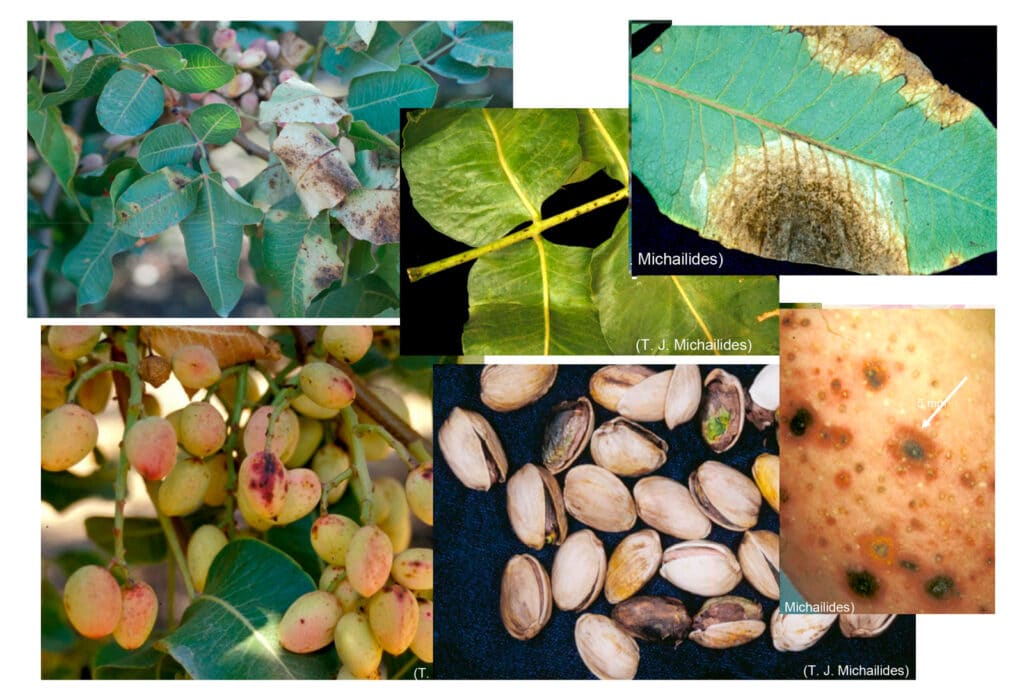
As for the fruits, alternaria can cause brown or black spots to form on their surface. These spots are usually small to medium in size and can affect the appearance and quality of the fruit. It is important to note that if the fruits are infected in the early stages of their development, they may not reach full maturity and, therefore, their quality may be compromised.
To prevent the appearance and spread of alternaria in the leaves and fruits of the pistachio tree, it is essential to carry out constant monitoring and apply appropriate preventive measures.
Prevention of alternaria in the pistachio tree
The prevention of alternaria in the pistachio tree is of vital importance to guarantee a healthy and productive crop. To do this, it is necessary to take specific measures both in the use of preventive fungicides and in the proper management and control of the disease.
Use of preventive fungicides
Preventive fungicides are a key tool in preventing alternaria in the pistachio tree. These products act as a protective barrier, preventing the spread of the fungi that cause the disease. It is recommended to apply fungicide applications before the appearance of visible symptoms, preferably in times of greater risk, such as summer, when temperature and humidity conditions are conducive to the development of alternaria.
It is important to highlight that the choice of the appropriate fungicide must be made based on the type of fungus causing alternaria. Consulting with experts or agricultural technicians can be of great help in determining the most effective and safest product to treat the disease.
Cultural tillage and control measures
In addition to the use of fungicides, there are other management and control measures that can significantly contribute to the prevention of alternaria in the pistachio tree. Some of these measures include:
- Surveillance and monitoring: Carry out regular sampling of leaves and fruits to detect the presence of the disease in time. This will allow for early and effective intervention.
- Hygiene and cleaning: Keep the plantation clean, eliminating remains of infected plants and avoiding the accumulation of fallen leaves on the ground, as they are usually a reservoir where alternaria can survive, even at low temperatures. These organic remains can become sources of infection and spread of alternaria.
- Irrigation optimization: Properly control the humidity in the soil to avoid excessive levels. Excess humidity can favor the development of the disease. It is important to ensure that the irrigation system is efficient and does not generate waterlogging.
- Pruning and thinning: Carry out adequate sanitary pruning to promote ventilation and the entry of sunlight, which hinders the development of fungi. Likewise, carry out thinning in the crop to reduce the density of plants, improving air circulation.
These measures, combined with the appropriate use of preventive fungicides, will minimize the risks of alternaria in the pistachio tree and maintain the health of the plants, thus increasing the production and quality of the fruits.
Treatments with chemical means
The use of copper compounds: copper oxychloride and cuprocalcium sulfate, has been shown to be effective in the treatment of Alternaria infections. In any case, treatments should be applied from full flowering until summer. The most appropriate time, if making a single application, is at the end of June and until the beginning of July, before the most critical period for the development of this disease, which, as already mentioned, is summer.
Phytosanitary products authorized for this use in the MAPA Registry of Phytosanitary Products can be used, if they exist, and can be consulted at the web address:
https://www.mapa.gob.es/es/agricultura/temas/sanidad-vegetal/productos-fitosanitarios/fitos.asp
Other care and diseases of the pistachio tree
Proper care and disease prevention are essential to maintaining a healthy and productive pistachio tree. In addition to alternaria, there are other common diseases that affect this crop, such as verticillosis and some more. These diseases and some measures for their management and control are detailed below.
Verticillosis: another disease to take into account
The verticillosis It is a disease caused by the fungus Verticillium dahliae, which infects the vascular system of the pistachio tree. This can seriously affect the growth and nutrition of the plant, decreasing its yield and fruit quality. Verticillosis symptoms include yellowing and wilting of leaves, and in severe cases, plant death.
To prevent verticillosis, it is recommended to implement the following measures:
- Select and use varieties resistant to the disease.
- Practice crop rotation to avoid the accumulation of the fungus in the soil.
- Carry out adequate fertilization and irrigation management to strengthen the resistance of the plant.
- Remove and destroy infected plants to prevent the spread of the fungus.
Other common diseases in pistachio cultivation
In addition to alternaria and verticillosis, there are other diseases that can affect the pistachio tree. Some of the most common are:
- botryosphere: a fungus of the Botryosphaeriaceae family that causes brown or black spots on the leaves, leading to desiccation and fall and can develop in conditions of high humidity.
- Septoria: caused by ascomycete fungi, such as Pseudocercospora pistacina, Septoria pistaciarum, S. pistaciae and Cylindroseptoria pistaciae.
- Rust (Pileolaria terebinthi C.): is a disease that affects the pistachio tree, producing spots on the leaves and causing their premature fall.
To manage these diseases, it is important to carry out the following practices:
- Maintain adequate cleaning and sanitation of the crop, eliminating plant remains and rotten or diseased fruits.
- Monitor irrigation and avoid excess moisture in the soil and leaves, as this favors the development of fungal diseases.
- Use authorized phytosanitary products preventively and following the manufacturer's recommendations.
With proper tillage and careful prevention, it is possible to reduce the impact of these diseases on pistachio trees, protecting the health of the crop and ensuring good production of quality fruits.
In pistachio cultivation, prevention and proper management of the alternaria disease are of vital importance to ensure good production and quality of the fruits. Adopting preventive measures and carrying out correct management will help control the spread of the disease, minimizing damage caused to the leaves and fruits.
Importance of prevention
The prevention of alternaria in the pistachio tree is essential to avoid the appearance and spread of the disease in the crop. The use of preventive fungicides before the first symptoms appear is an effective strategy to control the development of the fungi that cause the disease. In addition, it is important to maintain good health in the crop, carrying out adequate pruning and eliminating affected leaves and fruits.
Early detection of alternaria in the pistachio tree through leaf sampling in mid-June and until early July will allow timely preventive measures to be taken. This disease develops mainly in summer, with high temperatures and prolonged humidity, so it is crucial to pay attention to the weather conditions and constantly monitor the crop.
General recommendations for growing pistachio trees
- Maintain correct irrigation and drainage management, avoiding excess moisture in the soil. An adequate irrigation system is essential to prevent fungal diseases such as alternaria.
- Carry out regular pruning and remove dead or diseased vegetation from the ground, burying or burning it. This helps improve aeration and reduces the spread of diseases in the crop.
- Use alternaria-resistant varieties when possible. Hybrid or genetically improved varieties may have greater tolerance to this disease.
- Maintain a balanced fertilization program appropriate to the needs of the pistachio tree. A good nutritional state strengthens the plant and makes it less vulnerable to diseases.
- Control the presence of insects or pests that can weaken the plant and increase its susceptibility to diseases.
Taking into account these general recommendations for growing pistachio trees will help maintain proper management and prevent the appearance and spread of alternaria, as well as other common diseases in this crop.
Sources:
Means of phytosanitary defense and MAPA Registry of Phytosanitary Products
Do you need help preventing or treating Alternaria in your plantation?
We help you
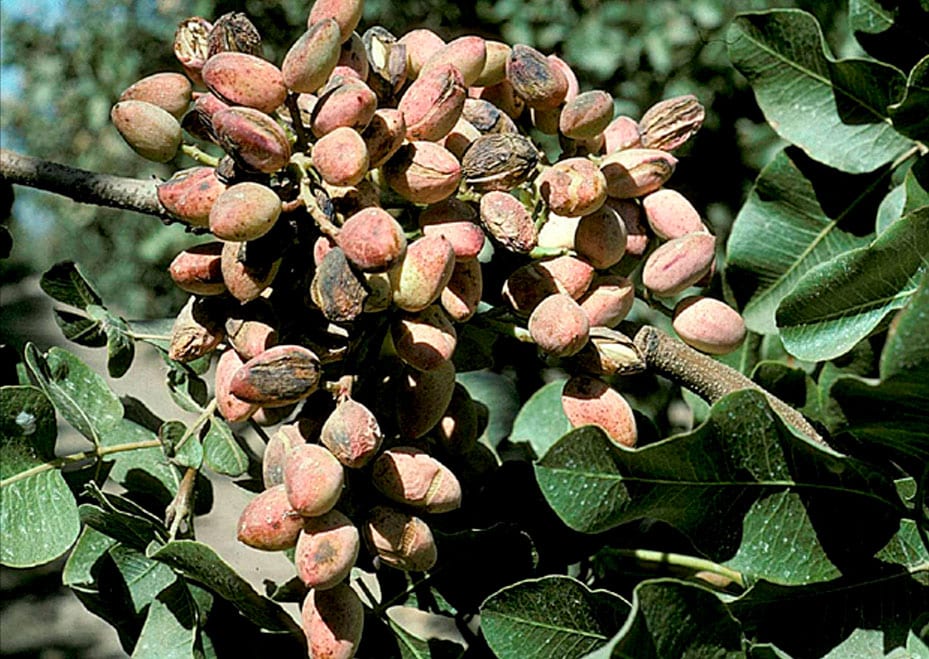
Related content:
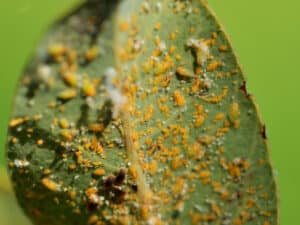
Pistachio psylla: A threatening pest in crops in Castilla-La Mancha and Extremadura
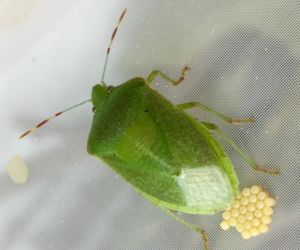
Pests of the pistachio tree: The green stink bug (Nezara viridula L.)
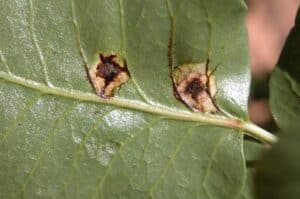
Rust in the pistachio tree: Pileolaria terebinthi C. and its impact
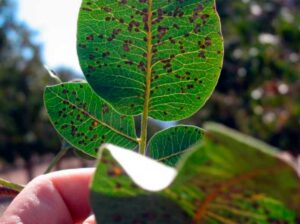
Septoriasis in the pistachio tree: Causes, symptoms and control measures.
Seeker:
Find out now:
You may also like:
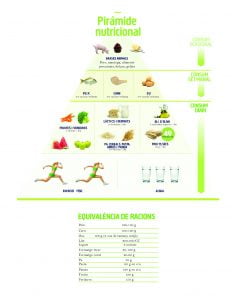
Pistachios star in the new pyramid of the Mediterranean Diet, one of the healthiest in the world.
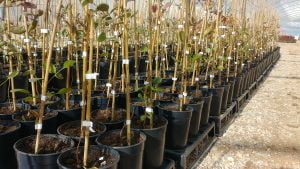

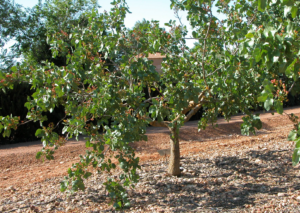
Pruning the pistachio tree: a key aspect in the cultivation and growth of the plant.
Entries by category:
- pistachio tree (1)
- Benefits of pistachio (4)
- Pistachio marketing (4)
- Price tables (3)
- Pistachio cultivation (8)
- Diseases and pests (8)
- Legal (7)
- Misterpistachio (1)
- Pistachio News (5)
- Rootstocks (2)
- Store (3)
Share this post with one click:
